หน้าบ้าน - หน้าร้าน, การแสดงออกถึงพื้นที่ส่วนตัวและพื้นที่สาธารณะของตึกแถวบริเวณถนน หน้าพระลาน-ถนนมหาราช (Shop or Home, the expression of public and private spaces of shop houses on Na Phra Lan Road and Maha Rat Road.)
Main Article Content
Abstract
บทความนี้กล่าวถึงตึกแถวหรืออาคารพาณิชย์ริมถนนในกรุงเทพมหานคร ซึ่งมีการใช้งานเป็นทั้งบ้านและร้านค้า หรือในอีกมุมหนึ่งคือ เป็นทั้งพื้นที่ส่วนตัวและพื้นที่สาธารณะ มุ่งศึกษาความน่าสนใจของพฤติกรรมผู้อยู่อาศัยหรือเจ้าของร้านแสดงออกผ่านองค์ประกอบต่าง ๆ เพื่ออธิบายถึงการใช้พื้นที่และวิธีการแสดงออกถึงความเป็นพื้นที่ส่วนตัวและพื้นที่สาธารณะบนพื้นที่เดียวกัน โดยใช้กรณีศึกษาจากตึกแถวบริเวณถนนหน้าพระลาน-ถนนมหาราช โดยเลือกกรณีศึกษาจากร้านค้าที่มีความน่าสนใจคือ 1. ร้าน ต.บรรจง ถ.หน้าพระลาน 2. ร้านมิ่งหลี ถ.หน้าพระลาน 3.ร้านรุ่งเกษม ถ.มหาราช และ 4.ร้านเจริญชัย ถ.มหาราช (ท่าพระจันทร์) การเก็บข้อมูลใช้วิธีเฝ้าสังเกตและถ่ายภาพ ผ่านหน้าบ้านหรือหน้าร้าน เวลา 4.00น. - 20.00น. รวมถึงการสัมภาษณ์ เจ้าของร้าน ผลการวิเคราะห์ที่ได้คือ เจ้าของร้านแสดงออกผ่าน 1.ระบบสัญลักษณ์ เช่น ยกเก้าอี้ขึ้นบนโต๊ะ การเก็บและแสดงสินค้าที่ตู้ขายของหน้าร้าน และ 2.การปิดกั้นเชิงกายภาพ เช่น การปิดประตูบ้านมากึ่งหนึ่ง การนำแผ่นพลาสติกขวางทางเข้าออก การนำข้าวของบางอย่างวางขวางทางเข้าออก ฯลฯ
อาคารพาณิชย์เหล่านี้แสดงให้เห็นว่า ความเป็นบ้านไม่จำเป็นต้องคงอยู่อย่างต่อเนื่องเสมอไป การใช้งานพื้นที่ส่วนตัวและพื้นที่สาธารณะสามารถจัดการได้ด้วยองค์ประกอบทางสถาปัตยกรรม วัตถุใช้สอยในชีวิตประจำวัน และตำแหน่งของกิจกรรมที่เกิดขึ้น หน้าบ้านเมื่อดูจากภายนอกเหมือนไม่ได้รับการจัดระเบียบ แต่ด้วยประสบการณ์ทำให้เจ้าของมีการแสดงออกถึงจากใช้งานพื้นที่ได้เป็นอย่างดี ความรู้สึกถึงความเป็นพื้นที่ส่วนตัวหรือพื้นที่สาธารณะอาจไม่ได้รับรู้ผ่านองค์ประกอบทางสถาปัตยกรรมเพียงอย่างเดียว
This article is about dwelling in commercial building (shop house) in Bangkok. That have two different functions, home and shop or private and public spaces, occuring in same area. Habits of the residents are the main subject of research and explain how residents allow customers to use this area. The case study is commercial building on Na Phra Lan Rd. and Maha Rat Rd. Shops being use as case studies are is 1). Tor Banjong, Na Phra Lan Rd. 2). Minglee Na Phra Lan Rd. 3). Rungkasem Maha Rat Rd. 4). Chareonchai Maha Rat Rd. The research methodology is observation and photographing the main entrance of the shops from 4.00am-8.00pm including interviewing the shop owners. The findings consist of the expression of privacy through 1. “Symbolic” e.q. lifting all chairs on the table, emptying the show case boards and 2. “Encloser” e.q. half closing doors, blocking the main entrance with plastic board, sitting at the main entrances.
From the case studies, we can conclude that the sense of dwelling isn’t always expressed continuingly. Public or private uses can be managed by architecture elements, everyday objects, and activity organization. From the outside, the shopfront may look like unorganized but the owner can clearly express public or private uses of space clearly. Sense of private space or public space may not be realized through architectural elements alone.

